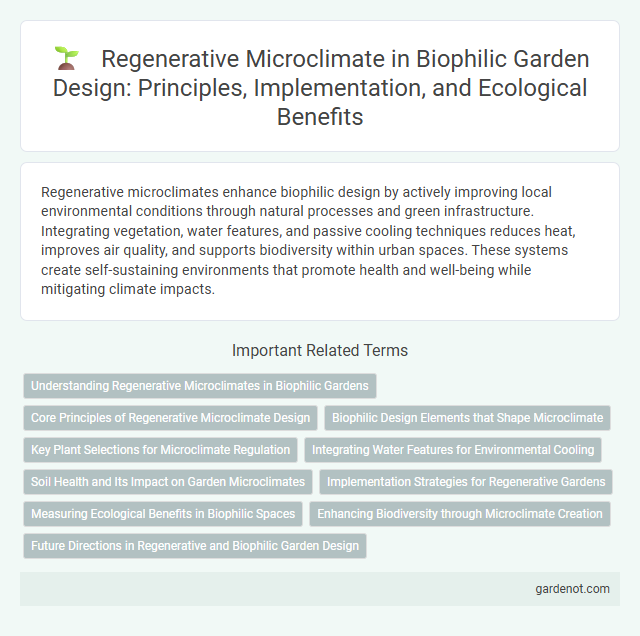Regenerative microclimates enhance biophilic design by actively improving local environmental conditions through natural processes and green infrastructure. Integrating vegetation, water features, and passive cooling techniques reduces heat, improves air quality, and supports biodiversity within urban spaces. These systems create self-sustaining environments that promote health and well-being while mitigating climate impacts.
Understanding Regenerative Microclimates in Biophilic Gardens
Regenerative microclimates in biophilic gardens enhance local ecosystems by mimicking natural processes to improve air quality, temperature regulation, and biodiversity. Key elements include diverse plant species, water features, and soil management that work synergistically to sustain ecological balance and promote resilience against climate stressors. Integrating these components supports healthy microhabitats, fostering vibrant interactions between flora, fauna, and human inhabitants for greater environmental regeneration.
Core Principles of Regenerative Microclimate Design
Regenerative microclimate design prioritizes enhancing local ecosystems by integrating vegetation, water management, and renewable energy to restore natural cycles and improve air quality. Core principles include promoting biodiversity, optimizing passive solar gain, and utilizing permeable surfaces to manage stormwater effectively. This approach fosters resilient environments that support human well-being while reducing urban heat island effects and carbon footprints.
Biophilic Design Elements that Shape Microclimate
Biophilic design elements such as green roofs, living walls, and strategically placed vegetation significantly improve regenerative microclimates by enhancing air quality, reducing urban heat islands, and increasing humidity control. These natural features facilitate thermal regulation through shading and evapotranspiration, fostering healthier and more comfortable indoor and outdoor environments. Integrating water bodies and natural ventilation channels further amplifies microclimate resilience, promoting sustainability and occupant well-being.
Key Plant Selections for Microclimate Regulation
Key plant selections for microclimate regulation in biophilic design emphasize native species with high transpiration rates that enhance local humidity and cooling effects. Deep-rooted plants improve soil stability and water retention, fostering a regenerative microclimate that supports biodiversity and reduces urban heat island effects. Integrating diverse functional plant clusters optimizes shade provision, air purification, and temperature modulation within built environments.
Integrating Water Features for Environmental Cooling
Integrating water features such as ponds, fountains, and misting systems in biophilic design significantly enhances regenerative microclimates by naturally cooling surrounding air through evaporation and heat absorption. These elements increase local humidity levels, reduce urban heat island effects, and promote biodiversity by attracting wildlife. Optimizing water feature placement near outdoor seating and pathways maximizes environmental cooling benefits and occupant comfort.
Soil Health and Its Impact on Garden Microclimates
Soil health plays a critical role in creating regenerative microclimates by enhancing water retention, nutrient cycling, and microbial activity, which in turn stabilizes garden temperature and humidity levels. Healthy soils support diverse plant life that improves air quality and promotes natural cooling through evapotranspiration. Integrating organic matter and reducing soil compaction fosters resilient soil ecosystems, ultimately optimizing the microclimate for sustainable garden productivity.
Implementation Strategies for Regenerative Gardens
Utilizing native plant species with deep root systems enhances soil health and water retention, creating a self-sustaining microclimate in regenerative gardens. Integrating rainwater harvesting techniques and permeable surfaces optimizes natural hydration cycles and reduces runoff. Strategic layering of vegetation provides shade, improves air quality, and moderates temperature fluctuations, promoting resilience and biodiversity.
Measuring Ecological Benefits in Biophilic Spaces
Measuring ecological benefits in biophilic spaces involves assessing air quality improvements, increased biodiversity, and energy savings linked to regenerative microclimates. Integrating sensors and environmental monitoring tools quantifies carbon sequestration, temperature regulation, and humidity balance within green infrastructure. These metrics support data-driven strategies to optimize biophilic designs for enhanced ecosystem services and human well-being.
Enhancing Biodiversity through Microclimate Creation
Regenerative microclimates foster biodiversity by creating localized environments that support diverse plant and animal species, enhancing ecosystem resilience. Integrating native vegetation and water features into building design stabilizes temperature and humidity, promoting habitat connectivity and species proliferation. This approach not only improves urban biodiversity but also contributes to climate regulation and ecological health at a micro scale.
Future Directions in Regenerative and Biophilic Garden Design
Regenerative microclimate strategies in biophilic garden design emphasize enhancing local biodiversity and ecosystem services through native plant integration and water-sensitive urban design. Future directions prioritize adaptive green infrastructure that supports carbon sequestration, improves air quality, and fosters resilient habitats amid climate change challenges. Innovations in soil regeneration and dynamic shading systems further contribute to sustained ecological balance and user wellness.
Regenerative microclimate Infographic

 gardenot.com
gardenot.com